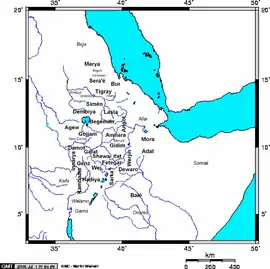Wej province
The Wej Kingdom was a small kingdom established in the 10th century and located in the southwest of what is now Ethiopia.
Location
According to G. W. B Huntingford, Wej occupied an area near Lake Zway, west of Fatager and east of Hadiya.[1][2][3]

Origins
There have been arguments over the ruling family's ethnicity. The extinct Maya are held by some sources to have been the original rulers, but others state that Wej campaigned against the Maya, while early Arab writers recorded that Oromos were living in the area and founded several kingdoms, Wej among them.[4][5]
History
Pankhurst states that Wej was an ally of Ethiopian king Yekuno Amlak and supported him in his conquest of Abyssinia. It is described as a tributary state ruled by Govorner Zebadar.[6]
Christian missionaries were sent annually to Wej during the era of Abuna Yaqob. He also sent Abba Iyosyas to supervise the kingdom, as well as neighbouring Almale and Gurage.[7]
Zway (Zay) Era 1400’s-1498
After the Fall of Ifat many ethnicity's and kingdoms fell weak amongst them the Oromo Muslims, so the Zay People expanded from there home land Enderta
when the Oromo first met the Zway people's they didn't know what they were doing due to there Smart modern fishing and sailing Techniques. The Oromo gave them the name Laqi which means Paddler. The Oromo and the Zway then allied them self's and lived together till the Oromo's campaigned against the Maya. It is also said that the Zay were a branch of the Harla.[8]
One noted ruler of the Zay dynasty of Wej is Ras Amdu who was a powerful king who invaded kingdoms, the Abyssinian's were so scared of him as well as the Muslims. One Chronicle Records this statement from the Court of Abyssinia.
“ let us also have the Protection of the Muslims so that we can achieve our aims, and bring them in so that our religion may not be changed. But there is Ras Amdu as long as he lived the Moslims are weak and scared”.
So they planned to spread lies about him, the main one was that he slept with Queen Eleni of Abyssinia when the Majority of Abyssinia heard this Amdu was furious so he led a campaign against the Maya, and Fetegar he defeated them very easily, according to Tadesse Tamrat he ruled the whole of the Maya,Genz,Fetegar,Wej, and Lake Hayq By himself with no Governors nor Garad's.[9]
but King Eskender went to support the Muslims the Abyssinian king captured and Killed Amdu. When the news spread that the second most powerful monarch of Ethiopia died his nephew, Welde Silus swore to kill Eskender. Welde ascended to the Thrown, the Maya and Zway people's then allied them self's with him, Welde led his forcers to Enderta, Eskender then Attacked them. Welde had Maya forcers which used Arrows dipped in poison. He him self killed Eskender The chronicle states that he swore not to spare the king, this would lead to Fetegar and Wej expanding, Wej and Fetegar invaded the Genz and Yifat province's and take their cattle with this Fetegar and Wej became one of the most powerful kingdoms in the Horn of Africa. They would also convert all the inhabitants of Genz and shewa to islam and Welde made his capital at Zway then known as Jarecho. All this would happen after their victories, and the Zway and Maya dynasties would live for the next seven decades.[10][11][12][13]
Conquest of Abyssinia
Wej became a Christian kingdom and was later one of the first to be invaded by Ahmad ibn Ibrahim al-Ghazi due to its religion and eastern location. Emperor Lebna Dengel received news of this invasion while at Geberge in Wej, but dismissed the threat as a series of raids. He left the city after appointing Wasan Sagad as king.[14][15][16]
Two noblemen of Wej, Azmach Fanil and Yonadab, took prominent roles in holding back the invading forces, and soldiers from the kingdom led a campaign against the Maya, who had recently converted to Islam. Later in Imam Ahmad's invasion, he sent his trusted general and advisor Mojhad to compel Wej to surrender, which it did before he even reached the kingdom. He established a poll tax in the area. After hearing of Mojhad's success, Imam Ahmad traveled to Wej and established a stronghold at Jog.
The current king of Wej, Eslam, had refused to capitulate and retreated to Gurage. However, when Yodab surrendered to Damot, Eslam sent his son and a nobleman named Asebo to make peace. When asked why they had returned, Asebo replied, "We have come to save our country and our churches." They agreed to pay the poll tax in exchange for safety from persecution. Eslam's son became a Muslim, as did all the courtiers and advisors of Wej, but Imam Ahmad allowed Eslam to remain a Christian.[17]
References
- Lebel. Hunting ford. 1965. p. 101.
- Waj. G.W.B Huntingford. 1965. p. 54.
- Meroid Wolde Aregay. Huntingford. 1974. pp. 272–3.
- The Journal of Oromo studys. Snippet view: Brakumper. 2008. p. 210.
- A river of blessings essays in honour of Paul Baxter. Snippet view: David Brokensha,Paul William Trevor. 1994. p. 52.
- Ethiopian Borderlands. Library of congress: Pankhurst. 1997. p. 76.
- Borderlands. Library of congress: Pankhurst. 1997. p. 77.
- Islamic History and culture in southern Ethiopia. Hamburg uni: Brakumper. 2002. p. 18. ISBN 9783825856717.
- Church and state in Ethiopia. (Oxford Clarendon Press): Taddesse Tamrat. 1972. p. 286.
- Lincei, Accademia Nazionale dei (1974). Problemi Attuali Di Scienza de Cultura Quaderno. Snippet view. p. 549.
- Problemi Attuali. Snippet view. 1974. p. 550.
- Problemi Attuali. Snippet view. 1974. p. 551.
- Problemi Attuali. Snippet view. 1974. pp. 551–552.
- Basset. Hunting ford. 1989. p. 128.
- Basset. Huntingford. 1958. p. 183.
- Borderlands. Pankhurst. p. 204.
- Borderlands. Pankhurst. 1997. p. 205.